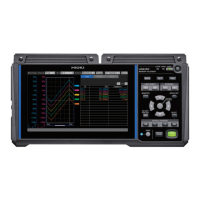41
Conguring Input Channels
6
Under [Slope], select the slope to count.
↑
Integrates the number of times the pulse switches from low level to high level (rising).
↓ Integrates the number of times the pulse switches from high level to low level (falling).
7
Under [Threshold], select the level to count.
1 V
Treats voltages that are greater than or equal to 1.0 V as high level and voltages that
are greater than or equal to 0 V but less than 0.5 V as low level.
4 V Treats voltages that are greater than or equal to 4.0 V as high level and voltages that
are greater than or equal to 0 V but less than 1.5 V as low level.
8
Under [Filter], select whether to use the chatter prevention lter.
Set to [ON] to prevent false counting due to chatter in mechanical contact (relay) output.
OFF
, ON
9
Under [Smoothing], enter the smoothing processing time (when [Range] is set to [r/min]).
1 s
to 60 s
Principal of rotational speed measurement
Under the following conditions, the integration pulse count is internally updated at a data refresh
interval of 10 ms:
• When the range is [r/s]
• When the range is [r/min] and smoothing is set to [1 s]
The rotational speed at time t [s] is calculated by dividing the pulse count from (t - 1) to t [s] by the
number of pulses per revolution.
r
(r/s) =
Integrated pulse count at t [s] − integrated pulse count at (t − 1) [s]
Number of pulses per revolution
r/s: Rotational speed per second
r/min: Rotational speed per minute (with smoothing set to [1 s])
r (r/min) =
Integrated pulse count at t [s] − integrated pulse count at (t − 1) [s]
Number of pulses per revolution
× 60
Example: Number of pulses per revolution = 4
Integrated pulse count at 1 s = P1 = 1000 c
Integrated pulse count at 2 s = P2 = 2000 c
The rotation speed at t = 2 s (r
t=2
) can be calculated as follows:
r
t=2
= (2000 - 1000) / 4 = 250 r/s
When the range is set to [r/min] and smoothing is set to t
0
[s], the integrated pulse count is
internally updated at a data refresh rate of 50 ms.
The rotational speed at time t [s] is calculated by dividing the pulse count from (t - t
0
) to t [s] by the
number of pulses per revolution and multiplying the result by 60.
r (r/min) =
Integrated pulse count at t [s] − integrated pulse count at (t − t
0
) [s]
Number of pulses per revolution
×
60
t
0
Settings and Operation
www.GlobalTestSupply.com
Find Quality Products Online at: sales@GlobalTestSupply.com

